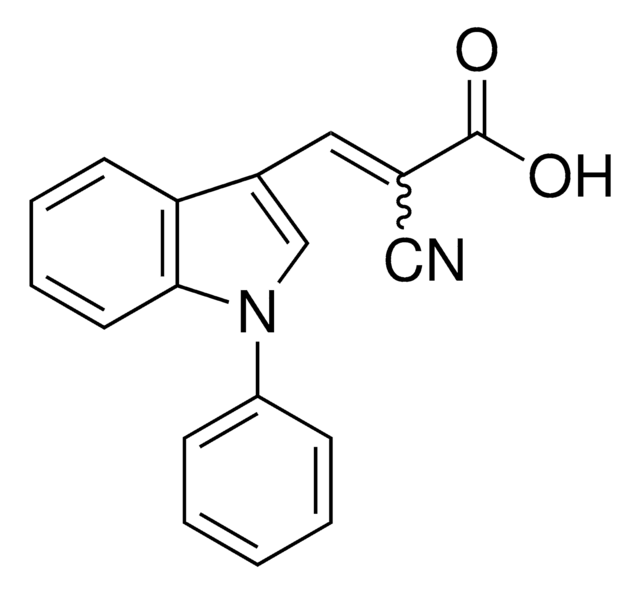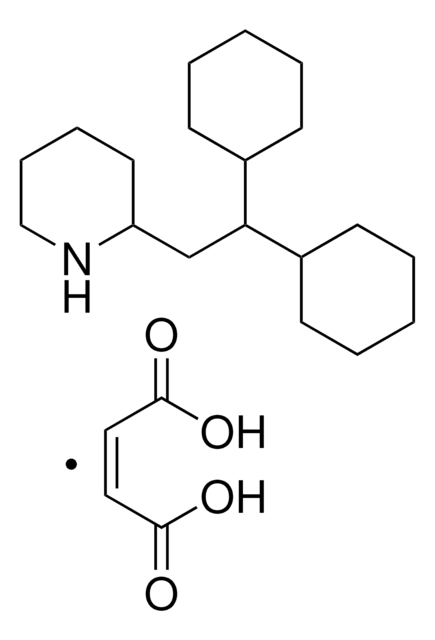Wichtige Dokumente
PZ0160
UK-5099
≥98% (HPLC), powder, mitochondrial pyruvate carrier inhibitor
Synonym(e):
2-Cyan-3-(1-phenyl-1H-indol-3-yl)-2-propensäure, PF-1005023
About This Item
Empfohlene Produkte
Produktbezeichnung
UK-5099, ≥98% (HPLC)
Qualitätsniveau
Assay
≥98% (HPLC)
Form
powder
Farbe
yellow to tan
Löslichkeit
DMSO: >20 mg/mL
Lagertemp.
2-8°C
SMILES String
OC(=O)\C(=C\c1cn(-c2ccccc2)c3ccccc13)C#N
InChI
1S/C18H12N2O2/c19-11-13(18(21)22)10-14-12-20(15-6-2-1-3-7-15)17-9-5-4-8-16(14)17/h1-10,12H,(H,21,22)/b13-10+
InChIKey
BIZNHCWFGNKBBZ-JLHYYAGUSA-N
Anwendung
- als mitochondrialer Pyruvat-Blocker zum Reduzieren des Pyruvattransports in die Mitochondrien im Roswell Park Memorial Institute (RPMI)-1640-Medium für Prostatakrebs-Zelllinienkulturen
- in Dimethylsulfoxid(DMSO)-Stämmen, zur Untersuchung der Folgen eines Hemmens des Pyruvattransports in die Mitochondrien bei proinflammatorischen Antworten in von Lipopolysacchariden aktivierten Makrophagen
- bei der Oberflächenbehandlung zur Untersuchung seiner Wirkung auf die Haarzyklus-Induktion in für Experimente verwendeten Mäusen
Biochem./physiol. Wirkung
Leistungsmerkmale und Vorteile
Lagerklassenschlüssel
11 - Combustible Solids
WGK
WGK 3
Flammpunkt (°F)
Not applicable
Flammpunkt (°C)
Not applicable
Hier finden Sie alle aktuellen Versionen:
Analysenzertifikate (COA)
Die passende Version wird nicht angezeigt?
Wenn Sie eine bestimmte Version benötigen, können Sie anhand der Lot- oder Chargennummer nach einem spezifischen Zertifikat suchen.
Besitzen Sie dieses Produkt bereits?
In der Dokumentenbibliothek finden Sie die Dokumentation zu den Produkten, die Sie kürzlich erworben haben.
Kunden haben sich ebenfalls angesehen
Verwandter Inhalt
n proliferating cells, the cell cycle consists of four phases. Gap 1 (G1) is the interval between mitosis and DNA replication that is characterized by cell growth. Replication of DNA occurs during the synthesis (S) phase, which is followed by a second gap phase (G2) during which growth and preparation for cell division occurs. Together, these three stages comprise the interphase phase of the cell cycle. Interphase is followed by the mitotic (M) phase.
Apoptosis, or programmed cell death (PCD), is a selective process for the removal of unnecessary, infected or transformed cells in various biological systems. As it plays a role in the homeostasis of multicellular organisms, apoptosis is tightly regulated through two principal pathways by a number of regulatory and effector molecules.
Unser Team von Wissenschaftlern verfügt über Erfahrung in allen Forschungsbereichen einschließlich Life Science, Materialwissenschaften, chemischer Synthese, Chromatographie, Analytik und vielen mehr..
Setzen Sie sich mit dem technischen Dienst in Verbindung.












